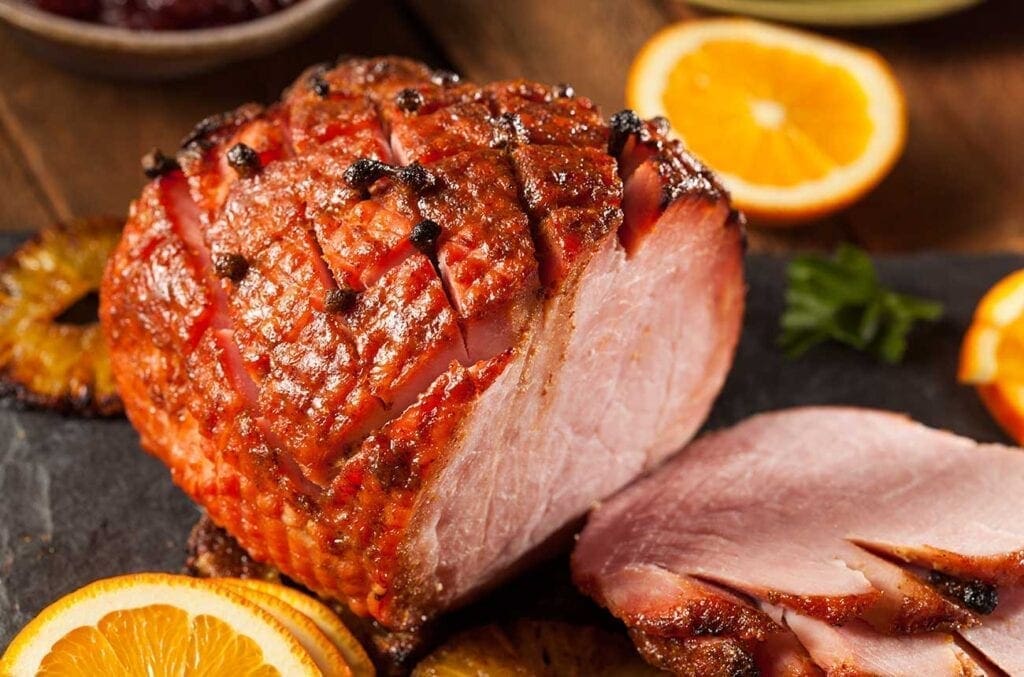The Christmas Ham? Cloves, and a nice ginger ale/brown sugar mixture, right?
Not at Chef Rocco Basil’s house. Instead? Think pancakes and Jim Bean.
But let’s start at the beginning, shall we?

“There are a lot of hams that are available out there, but I’ve always enjoyed preparing a bone-in ham because of the flavors that are added because of the bone,” Basil explained. “Plus, you have the bonus of being able to make a pot of ham and bean soup with that bone, and who doesn’t like a real good bowl of ham and bean soup?
“For those who are fearful of properly carving a ham, you can buy one of those spiral hams that has the bone,” he said. “But if you do a spiral, you’re going to want to cover it with foil during the first phase so the meat doesn’t dry out before the basting begins.”

To Clove or Not to Clove?
It is popular practice to stud the Christmas Ham with cloves because the seasoning flavors the meat very well, but Basil opts not to add the spikes, nor does he layer it with pineapple slices. Instead, he allows the basting to do the work.
“Now, for a regular bone-in ham, I prefer to do a whole ham instead of a half because that’s going to give between 15 and 20 pounds of meat,” Basil said. “I know most folks use the cloves for the ham, but I have never been a fan of using those. What I like to do is use a knife to cut small diamond in the fatty areas of the ham.
“That will allow the seasonings you put on the ham to reach the meat to add even more flavor,” he said. “Plus, I know that most people like to use ginger ale and brown sugar as a basting, but in the very beginning of the roasting process, I don’t baste the ham with any sort of liquid on it. That part of the process comes later. And remember, the majority of hams that are sale at the store is already a fully cook ham, so what we do at home is re-heating it.”

Patience and Safety
There are hickory smoked hams, city hams, country hams, ham shanks, and butt end hams, and Basil says whatever we purchase is going to be a wonderful ham as long as it is properly and safely prepared.
“And I say safely because the way I make my hams, there is a slight chance there could be a subatomic explosion of sorts,” he joked, kind of.
“In the beginning, we want to roast it slowly, so it’s a good idea to begin at 250 degrees until it reaches 135 degrees,” Basil instructed. “That’s when the basting comes into play, and my preference is using real maple syrup. I have the syrup in a skillet or a pot on the stove to reduce it before taking the skillet off the stove to add several ounces of bourbon. You don’t want to do this while the skillet is on the stove because it will ignite. That’s where that explosion could come into play.
“After adding and stirring in the bourbon real well, you’ll want to put the skillet back on the stove and put the heat on a super low to burn off the alcohol, but don’t worry because that taste of the bourbon will remain mixed with the maple syrup,” he continued. “You can add either a cinnamon stick if you like that flavor, or you could add some Dijon mustard, or something like that. Personally, I just use the maple syrup-bourbon mix with some butter in it for my hams.”

Baste Away
The final phase just might be the most important.
Whether you use a baster or a large spoon, basting often in a higher heat is definitely a vital part of the Christmas Ham process.
“As soon as your basting mix is nice and thick, you should spoon that sauce over the ham, especially where you have made your cuts,” Basil said. “Once that’s completed, turn that oven up to 350 degrees and plan on basting the ham really well every 10 minutes or so and that will give it a very nice candy coating. That’s going to add a lot of great flavor to that meal.
“The goal is to warm that ham to about 150 degrees because once you remove it from the oven the residual heat is what is going to finish it off while you let the ham rest for about 10 minutes before carving,” he explained. “If you want to some dark, crusty pieces, you can braise it in the oven and turn on your broiler. If you decide to do that, though, don’t walk away from it because you’re going to want to keep an eye on it so it doesn’t get too well done. After the 10 minutes, carve it the way you wish and have a wonderful holiday.”



